I have been anticipating this game ever since back in 2014, when Ninja Theory released their first teaser trailer for it and Senua looked nothing like she does now (well, maybe her general feel and idea). You could say that Hellblade was love at first sight … trailer, much like I was with Ori and the Blind Forest when that trailer came out. And I am super happy, pumped up and excited that it did not disappoint, much like its 2D platformer counterpart.
Indeed I was begging the Gods for Ninja Theory not to screw something up, because I was so in love with this game and its themes. They managed to catch my favorite mythology and my favorite goddess of that mythology to top it off. Also Senua’s image and her battle with mental illness – something people do not usually do justice by when presenting to the open public, however, I gotta say kudos to you Ninja Theory you did a damn fine job at that.
Before I get too ecstatic about things, I’ll save up for the final paragraph, let us start breaking down the review little by little and me actually telling you about this amazing experience.
The story of Hellblade follows the incredibly difficult journey of a Celtic warrior, named Senua. She faces darkness in the face of psychosis and her extremely personal journey is mostly generated by her own mind. This is all based on stories she has heard about the Northmen and their deities.
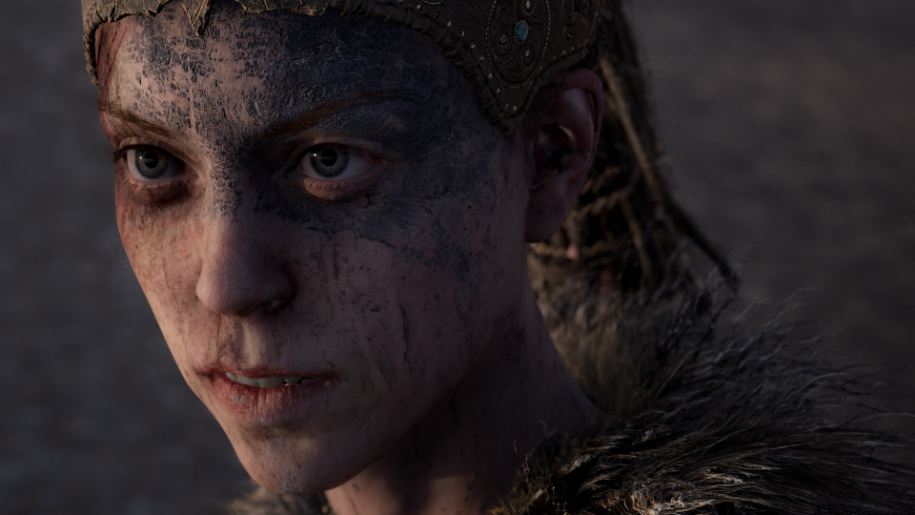
I am going to put the SPOILER TAG here, since I wish to go on about the story.
So basically, Senua inherited the psychosis from her mother, Galena. Her father – a druid, named Zynbel, treated it as a plague and told Senua that she was cursed, making her believe that. So he kept her locked away from the world, continuing to emotionally damage her mind, in order to “battle the darkness” and burned her mother alive to “appease the Gods”. One day, when she was walking around a big tree (which looks damn fine, if I may say, both in the past and the present), on one of the rare occasions when she left her home, her eye is caught by a man, named Dillion, whom she watches from afar and learns sword-fighting from. When they finally meet, he tells her that he is here for the warrior trials and encourages her to watch him, because he was impressed by how much she had learned just from observing him. Senua grew fond of Dillion quickly (and vice-versa) and she saw him as her ray of light in her world of darkness. However, when a plague broke out and took many lives, including Dillion’s father, she began to question herself, whether actually what Zynbel told her is true or not. For this reason Senua decided to venture into the wilds in isolation, in order to battle the darkness and cure herself of it, promising to return to Dillion when she did. There she met Druth – a scholar, who had barely escaped his Northmen masters, who told Senua stories of them and their Gods. Eventually, he died from his wounds, because he was badly burnt, but vowed to guide Senua in this life and the next. However, when Senua thought to have defeated her darkness, and returning home from her journey, she found a horrific scene in front of herself – her village raided, her home burnt, everyone killed off by the very Northmen that Druth had warned her about and to make matters worse, she found Dillion’s corpse, who was sacrificed to the Norse Gods in a gruesome ritual, called “the blood eagle”. Extremely vulnerable and traumatized, Senua suffered a mental breakdown and this is where her in-game journey begins.
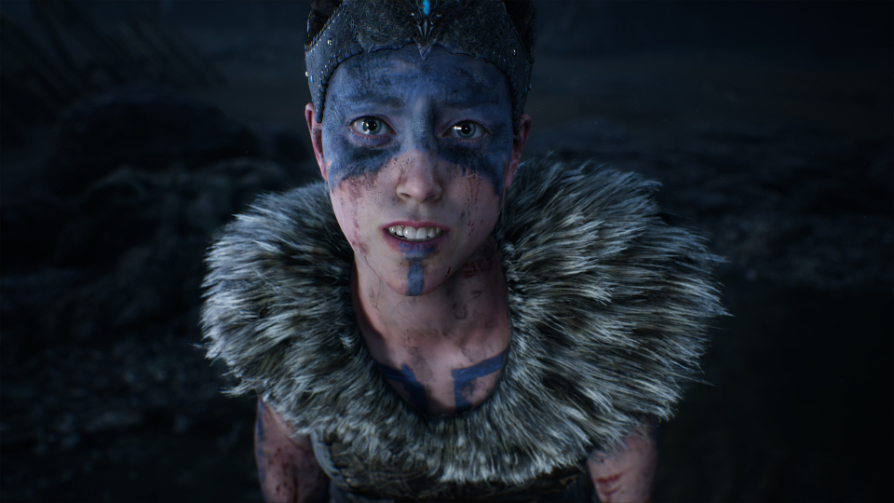
Remembering Druth’s stories about the Northmen, Senua was convinced that she could save Dillion’s soul from death, by venturing into the Norse realm of the dead – Helheim and bargaining with Hela – the goddess of death. So she took Dillion’s head and ventured north. In this journey, guided by her own mind and the stories she heard, Senua overcomes many obstacles, until she finally reaches Hela. She however is seldom merciful and overwhelms Senua with enemies. The latter both curses and pleads with the goddess to no avail as she is killed by her. However, once Hela drops Dillion’s head into the abyss and the camera turns back on her, we see Senua. By this Senua finally accepts Dillion’s passing and realizes that her psychosis is not actually a curse, nor a plague, nor was it responsible for the deaths caused by the Northmen and her mother’s passing. Helheim’s gruesome imagery fades away and Senua emerges victor in this battle with herself.
END OF SPOILERS…
I do believe that the story itself is very unique, because, yes at the very basis, it revolves around Norse mythology and such, but it is presented in a unique way, emerging the player into Senua’s world, seeing through her mind’s eye, experiencing every story came to be. Speaking of that, during the game, the only collectables are called lorestones, where each one has a story to tell. Usually they are spread amongst sections and tell a complete story, which is one those Druth told Senua, but I have to say they were very interesting to collect. Most of them are very hard to miss, but some can be a bit tricky. There are 44 in total and the game keeps track of the ones you have collected by coloring them blue on the lorestones beyond that.
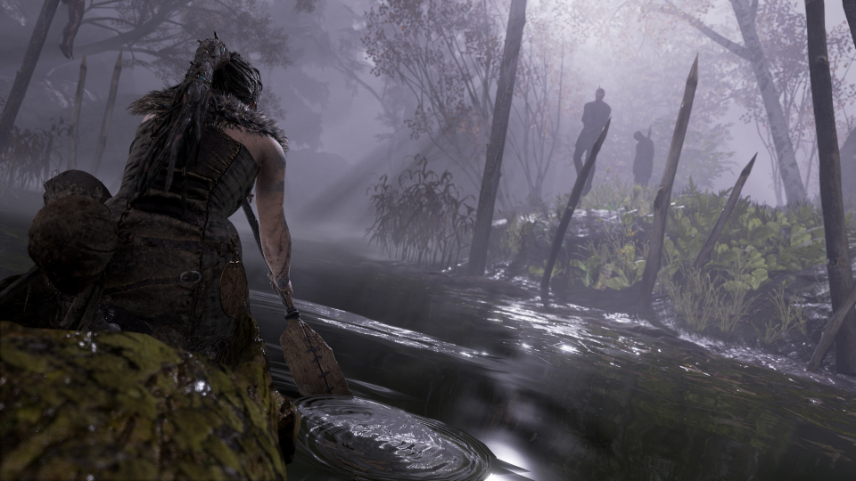
I also think that Hellblade raises awareness for the very delicate topic about mental illness and more specifically about psychosis and schizophrenia – two things surrounded by stigma, just because of how media has been presenting them to the public. In all things, by working with specialists and patients on this, Ninja Theory, created an amazing experience, filled with realism, showing us the difficult journey all people, with these illnesses have to go through.
In truth, you’re going to question yourself, and a lot, what exactly is real and what not in Hellblade? As they progress forward in Senua’s journey and experience her memories, the player is able to put the pieces of the puzzle together and is met with an answer to most of those questions, however, the journey itself is still widely mysterious, because most of it is created by Senua’s own mind. Hence why it’s hard to trust one’s eyes, when everything could be an illusion…
I love this concept and the way it is incorporated into the game. It’s not your typical experience where you face a tutorial and then there is a HUD telling you a bunch of stuff, vital to the player. In Hellblade we are guided by very subtle elements – there are no objective pointers, there are no quest markers, we are left to follow our own hallucinations and the best implementation of the game – the voices in Senua’s mind, or as they are referred to in game – the Furies.
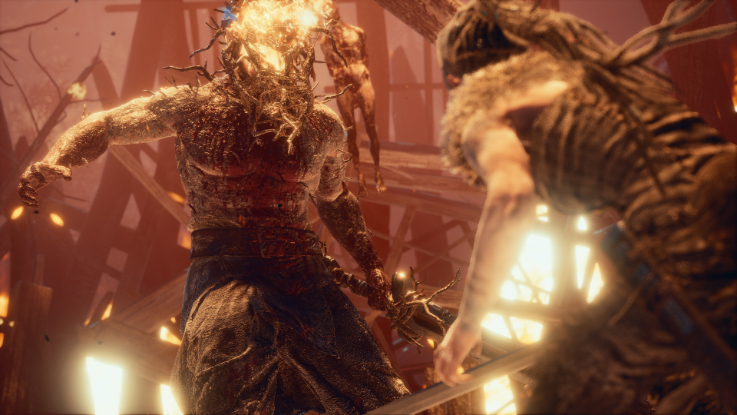
Basically Senua is accompanied by many voices – some kind and compassionate, some a bit discouraging, but they whisper to the player (or as in the game goes, to Senua), commenting on her every move, and guiding her both on her journey and in battle. And I have learnt this over the span of my 8 hours with this game that the best thing a player can do is just give in and listen to the Furies, because they are the best guide there ever could be. When solving puzzles, they will guide Senua to when she is getting close to the answer or will mock her when she goes the wrong way or does the wrong thing. Also they tell her where the progression path goes and warn her of danger or incoming battle. And speaking of battle, they are the most helpful thing in terms of the combat system. I won’t go into detail here and instead wait to get to that section to find out more. Other than those voices, there are two other distinct ones present – the darkness itself, who tries to discourage Senua from her quest and mocks her weaknesses and a gentle female voice, which speaks of Senua to the player and in a way tells her story.
Apart from her inner voices, Senua is guided by her own illusions and to be fair I find really helpful that the game highlights the area where hidden runes are, in order to guide the player, indirectly. Of course it does revolve around some fidgeting with the environment and actually finding the runes, but it never really felt that impossible or hard and I never felt lost. You know me, I do cheat, when it comes to puzzles, but I never once did cheat for this game, because with the visions and the voices, you cannot have a better guide.

To this end, I will say that Hellblade is a game that progressively gets better and better. As you venture further down the storyline, the combat gets harder and more tactical, indeed you learn new things with every different step you take and even in such a subtle way, there is always something new introduced in terms of providing a new and unmet experience for the player to which they have to adapt and learn from. Hence why I really took my time and embarked on the journey that Hellblade is. Not only because I owed it to myself and the game for waiting for it so long, but the fact that, now having completed Hellblade in my own explorative and slow manner, I can say that this is not your typical game where you can second-guess most of the things that happen at the end and rushed reviews do not do it justice. And trust me, this game deserves all the justice it can get, because it was such an amazing experience and I would love to venture down this game again in the future.
Moving on, let us finally talk about combat. I have seen a lot of people say that Hellblade in combat is similar to Dark Souls, in terms of feeling and execution, however more forgiving I suppose. To some extent I both agree and disagree with that.
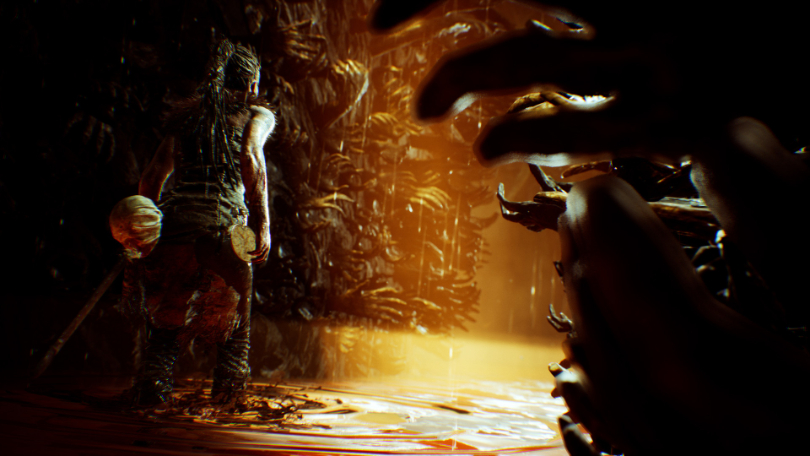
If I have to use one word to describe my state when fighting in the game, that would be focused. Indeed when it comes to combat I am usually very savage and I tend to just rush straight on into battle. However, in Hellblade – the more you rush, the worse it is for you, because sometimes rushing can get you killed, trust me, I’ve not only died once or twice. In reality, combat is very unique. It features an auto target system, where the camera would focus on one enemy at a time, no matter how many they are and target that particular enemy. You can change targets, however not willingly. The game will automatically refocus on the last enemy you have parried or blocked an attack from. Sometimes this is a bad thing – sometimes this is a good thing and I found myself trying to refocus on a certain amount of occasions. Also, because of this targeting system, many enemies can flank you or outright move behind you and do whatever it is they please. Now, in most cases I would probably treat that as a negative, however, here it is not the case. This is because first of all, the game focuses on putting the player on edge and trying to show them what it is like to be afraid of being outnumbered and flanked in real battle. Because Hellblade is heavily based on psychosis and the fears that come from it, I think this touch brings a very unique perspective into combat. You have to consider your position all the time, consider that an enemy may strike at any given moment, doesn’t matter if you are attacking or parrying or counter-attacking, they are their own entity and they strike back whenever they see an opportunity. In truth, most combat games’ enemies have this pattern where enemies will not attack you when something else is attacking you, in order to avoid overcrowding of enemies. Here, this is done exactly with the purpose to instill uneasiness and fear into the player’s mind.

Another unique aspect to battle are the Furies that we talked about earlier. I mentioned that even if most might mock Senua 90% of the time, they do guide her through combat and they do a really great job, if I might add. They encourage the player not to get surrounded, warn them when they do, advise to find a better position, they always warn when an enemy is about to strike, especially if it’s from behind and also, warn Senua whether to evade or block certain attacks, depending on their nature. Indeed, I found out that the best thing I can do, while playing Hellblade was to completely listen to all the voices and let them guide me, not missing on to a single word. For a fact, I was getting worried when they were getting quiet, or not talking to me on some occasions. Not to mention that it feels less lonely when they are around.
The final thing about combat I will mention is the actual technicality to it. In terms of gameplay, you have a light and a heavy attack and you can chain combos between the two. I really enjoyed seeing Senua move in battle. She was both fierce and graceful and never flinched. Other than that, the player can evade attacks or parry them. When you parry an attack at the last moment you can unleash a strong counter attack back at the enemy. I also loved the fact that visually the game is telling you how injured the enemy is. Usually they are straight up, walk faster towards you, and the more you attack them the more cuts will be present on their bodies and at their weakest point, they will be hunched over and walking slower towards you. Also the voices do a very good job and pointing these things out. On another note, Senua has this mirror with her, which serves as a gauge of a sort. When filled, she can focus and slow down time, inflicting more damage to her enemies and getting up quickly when knocked down. Now I was a bit of an idiot here, because it took me a while to learn to listen to the voices completely, because I found out about this focus thing about 1/3rd into the actual game, which made me laugh at myself mainly. Also, another 1/3rd into the game, when I got to the Sea of Corpses area, I found out that when they knock you down, you can try to get up with the focus button, which made my life a lot easier and saved me a lot of deaths for the future (which was basically the last 1/3rd of the game left). Moral of the story – listen to the voices. And this is what I mean that you can learn new things around every corner and I loved that I myself discovered that, by trial and error and not by any tutorial.

On the note of that, let us mention the perma-death controversy that has been circling around the internet. When facing your first battle ever in Hellblade, the game tells you about how Senua is infested with the rot and it is slowly crawling to her head, the more we die. When it gets to its destination, we will permanently die and lose our progress along the quest. Now whether you actually die or not, I cannot say, because I did die a handful of times, especially in the beginning when I wasn’t so seasoned with the combat and was dying left and right on the Surtr trial – to my surprise I managed to kill the actual boss on my first try. But I never really got to that point to actually lose any progress. Now in my opinion, most people cry and whine about this, but I think it’s a clever way for Ninja Theory to play with our minds. It’s a psychologically heavy game and of course it will play mind-games with the player. So why not, instill some fear of permanently dying to the player. Just like Senua, they would try their best to stay alive in their journey and not fail miserably. Whether or not it has actual consequences, it matters little, when the game tries to get to the player on a mental level. Of course it’s nice to have some punishment, lest the player gets too comfortable with it, however, I myself enjoyed this “controversy”. Not to mention that as the story goes on, the rot does visually spread across her right arm and at the end towards the left side of her face too.
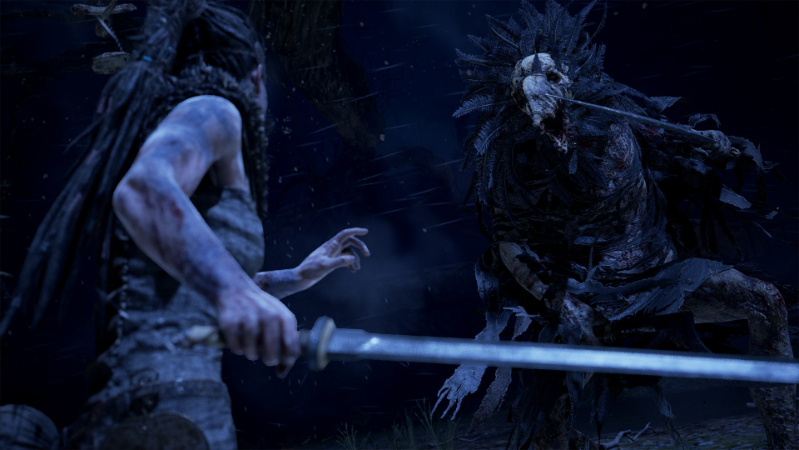
Beside battle, Hellblade features puzzle elements in itself. Most of them are connected to the hallucinations that Senua sees, or even illusions, created by her mind’s eye. Typically puzzles revolve around scanning the environment for runes, to open unlocked doors, or following a pattern of illusions (especially in the Valravn trial), to progress further down the path. As I mentioned, the voices help out a lot, Senua’s visions do too and you are never really lost in to what to do or where to go, because there will always be something to guide you – visually or sound based. Puzzles do get progressively more challenging and varying and we are offered with a lot of unique experiences. For example, when we have to assemble the sword Gramr, by completing the 4 challenges. One of them is a labyrinth in a crypt, which we must find our way through. Another is in a tower, where we have to alternate between the past and present state of the tower to reach our goal. Then we have an illusion swamp and the one, which I loved and I hated the most at the same time – the blindness challenge. Basically you navigate through a really dark area, and are entirely dependent on you hearing. Sometimes you get glimpses of the objects around you, which help a lot. And of course there are monsters in the dark, which you have to navigate through. Top it off, the only comforting thing is Dillion’s voice from time to time, because the Furies are not speaking at all. I felt on edge the entire time, to be fair. But that’s not all, we get other different challenges and mechanics. For example, where you are chased by Fenrir in the dark, or in the beginning of the game, where you get to pick between going after Surtr or Valravn first, both paths have different puzzles in them. Yeah it’s true that Surtr’s trial is more combat based and so puzzles revolve around finding runes and backtracking our way through fire, which was very tense. Valravn’s path was more puzzle based, where you have to align ravens, follow illusions and solve them. In the end, I was surprised that for me Surtr was an easier boss (and trial), than Valravn, even if people claim it to be the other way around, and recommend going for Valravn first.

Last before we reach the end is sound. Obviously, Hellblade is heavily sound-based with all the voices you have to pay attention to and it’s a 100 times better experienced with headphones. If you can pull off surround sound, even better. Makes it seem as if the voices are whispering directly to your head and it sounds so realistic. Sometimes, we have to pay attention for environmental sounds, for example in the battle with Fenrir or when following Valravn’s song. Beside that the general original soundtrack is amazing and I would love to get a release from Ninja Theory on that front. The music is just so amazing. Andy LaPlegua and David Garcia did an amazing job with the composition of the songs. Really hoping for a full OST release and can definitely say that as much eye candy as Hellblade is, it’s twice the ear candy experience.
Speaking of graphics, I cannot neglect the gorgeous interpretation of Helheim. There were definitely stunningly beautiful sceneries (for example the beach, the draconic tower, Senua’s memory about the tree) and psychologically terrifying ones (the dark puzzle, the underground caves, where Fenrir dwells, the grizzly rotting swamp), also I really enjoyed the balance between the light and the dark version of the tower puzzle. That was such a great contrast between the two – both visually and sound-wise. Also I love how they incorporated the characters as live motion capture and most important side characters like Druth, Galena, Dillion and Zynbel were implemented as a live audio and video, superimposed into the game world. I also love the way Melina performed Senua and give her all of my thumbs up and approval, because this is her first acting job.

Anyways, we have reached the end of our own written journey and now I must give the verdict and say my concluding words. To be honest, I am sad that Hellblade is over and I am sad that it is so short, however, if I think about it, it’s a unique AAA experience, half-priced, but also half the time. However, I wouldn’t have missed it for the world, that’s why I pre-ordered it straight when it was released for pre-order on steam. Hellblade is also a game which the player will absolutely love completely or not like at all, and trust me I loved the entire experience of it, and would love to play it again. There was a huge lash towards a darkness bug, where if you do not light your torch in Fenrir’s lair, you won’t be able to progress, but luckily with enough attentiveness and heeding the voices you can’t really miss not doing that. This is due to the save system of the game and the points of no return. Usually I am very picky about save mechanics, however here I can say that the way they did it, while not entirely player-wise practical, it is definitely immersive into the setting of following a journey, and not being able to go back.
As a verdict, I believe this will be my first 10/10 /no regrets on this/ and I do think that Ninja Theory did one hell of a job here. I want to congratulate them on the hard work and I hope it pays off in the love of fans about this game. Truthfully an amazing experience and this will be the second game for me, which if I can get amnesia and forget all about the playthrough, just to feel it again, I’d totally go for that. I can, without a doubt, recommend Hellblade to everyone. It’s definitely one of those rare gems out there on the market that I am absolutely happy to have.

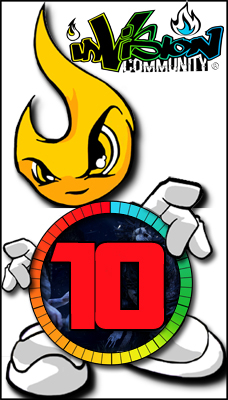






You must be logged in to post a comment.